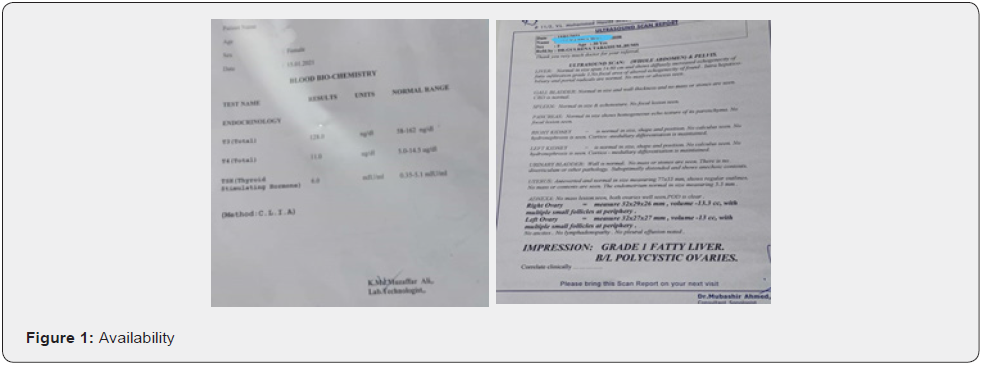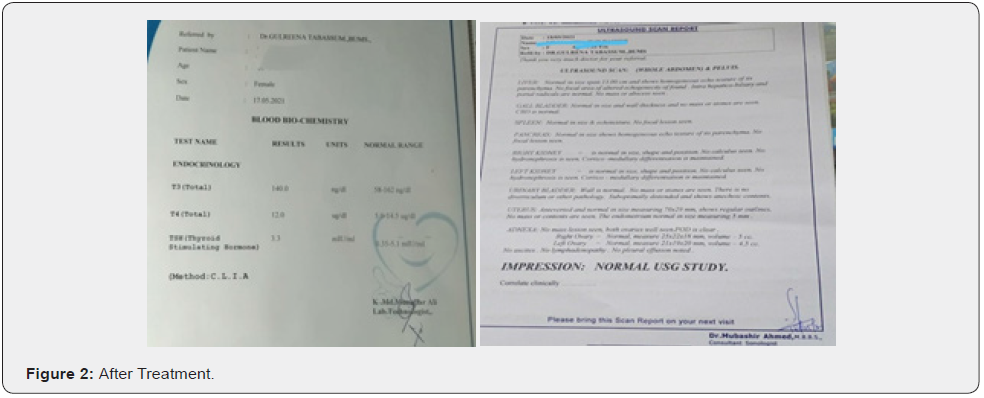Role of Unani Drugs in PCOS- A Case Report
Asiya Rashid1*, Zikra Tahseen1 and Gulrena Tabassum2
1Department of Ilmul Advia, National Institute of Unani Medicine, India
2BUMS, Government Unani Medical College, India
Submission: February 18, 2022; Published: March 24, 2022
*Corresponding author: Asiya Rashid, Department of Ilmul Advia, National Institute of Unani Medicine, India
How to cite this article: Asiya R, Zikra T, Gulrena T. Role of Unani Drugs in PCOS- A Case Report. J Gynecol Women’s Health 2022: 23(2): 556109. DOI: 10.19080/JGWH.2022.23.556109
Abstract
Background: Polycystic Ovary Syndrome (PCOS) is a hormonal, reproductive, and metabolic disorder that affects women of reproductive age. It is characterized by disrupted menstrual cycle, hyperandrogenism, acne, weight gain, hirsutism, diabetes propensity, depression, mood swings, and sub fertility. In Unani system of Medicine, it is described under the term ‘Ihtibas al-Tamth’ and ‘Uqr’.
Case presentation: The subject of the study was 35 years old female; she was diagnosed as a case of PCOS. Treatment was planned which includes lifestyle modifications as well as pharmacotherapy (Itrifal Gududi and Maajoon Dabeedul-Ward). Evaluation of patient was done before and after treatment using USG and Thyroid profile as a tool. There was significant improvement during entire period of treatment.
Discussion: The purpose of this case study was to determine the benefits of Unani drugs as it is evidenced by this report. During the treatment period, the patient recovered her menstrual cycles regularly, improved appetite and lost 2 kg weight, normal USG study and TSH levels within the range.
Keywords: Ihtibas al-Tamth; Uqr; Amenorrhea; Hirsutism; Hyperandrogenism; Unani medicine
Abbreviations: PCOS: polycystic ovarian syndrome; PCO: Polycystic ovaries
Introduction
Polycystic ovarian syndrome or Polycystic ovarian disease is heterogenous in nature, major multisystem endocrinopathy among reproductive aged women. It was first described by Stein and Leventhal in 1935 [1]. A group of symptoms such as amenorrhea, hirsutism, infertility with bilateral polycystic ovaries and thickened ovarian cortex are known as polycystic ovarian syndrome (PCOS). Polycystic ovaries (PCO) explain the appearance of ovaries on ultrasonography whereas PCOS is an appropriate term when PCO are associated with oligomenorrhea and symptoms of hyperandrogenism [2].
It affects 4-20% of women worldwide in their reproductive age [3]. In 70% of PCOS patients, excessive hair growth primarily along the lower jaw, upper lip, and chin, is found [4]. As far as its etiology is concerned, it is heterogenous disorder which is characterized by production of excessive androgen mainly by the ovaries. It has been suggested that it may be due to pathology in up regulation of enzymes in androgen biosynthesis and dysregulation of the CYP 11a gene [5]. PCOS includes clinical features such as oligomenorrhea, amenorrhea or DUB, hirsutism, recurrent abortions, obesity, infertility, acne, and acanthosis nigricans [5,6].
According to American Society for Reproduction Medicine, diagnosis of PCOS is based upon the presence of any two of the following three criteria i.e., Oligo and/or anovulation, Hyperandrogenism (Clinical and/or biochemical) and Polycystic ovaries. Investigations to be done in PCOS include ultrasonography, serum levels of FSH, LH, TSH, prolactin, lipid profile.
On USG, PCO can be diagnosed when ovarian volume is increased (≥ 10cm3) and ≥ 20 follicles arranged peripherally per ovary. Each follicular cyst measures about 2-9mm in diameter [5]. In conventional system of medicine, management of PCOS case includes exercise, lifestyle modification and pharmacotherapy such as metformin, gonadotrophins, ovulation inducers, progestins, combined oral contraceptives and antiandrogens [5].
In Unani system of Medicine, PCOS has been explained under the heading of ‘Ihtibas al-Tamth’ and ‘Uqr’ [7-10]. According to Rhazes, constellation of signs like hirsutism, obesity, acne, hoarseness of voice and infertility conjoined with menstrual abnormalities like amenorrhea, oligomenorrhea are suggestive of PCOS [8-10]. Hippocrates stated that a woman having scanty flow during periods or duration of flow <3 days may have robust body, healthy complexion with masculine appearance and infertility [9,11].
According to Zakaria Razi, ‘Ihtibas al-Tamth’ occur in fair women with phlegmatic temperament [9,11]. The cause of ovarian cysts is believed to be due to Su-i-Mizaj Barid Kabid which leads to abnormal production of phlegm. Increase in Khilat-e-Balgham and its dominance in body may lead to formation of cysts in the ovaries [12,13]. This case study was aimed to highlight the Unani drugs used in the treatment of PCOS.
Case Study
Patient Information
35 years old female presented to the Gynecology and Obstetrics OPD, Government Unani Medical College, Chennai with complaints of irregular periods, spotting, and anorexia. An irregular period described by her was amenorrhea for 3 months followed by spotting. Patient was suffering from this pattern of menstrual cycles since 2 to 3 years. She had not received any treatment for the same till yet.
Diagnostic Assessment
On examination patient’s vital was stable. She was having male type hair pattern above the upper lip. Her weight was 85 kg. She was examined systemically, and no abdominal and pelvic mass or tenderness was found on local examination. Patient was advised to do Thyroid profile and USG abdomen and pelvis. USG documented Grade I Fatty Liver and Bilateral Polycystic ovaries. Her TSH was 6mIU/ml. Based on history, examination and USG report, patient was diagnosed as a Case of Polycystic Ovarian Disease (Figure 1,2).


Therapeutic Intervention
The treatment protocol was planned which included lifestyle modifications as well as Pharmacotherapy. In lifestyle modifications, patient was advised to do exercise daily at least for 40 minutes and restrict junk food, fatty and fried diet. Patient was subsequently given Itrifal Gududi in a dose of 10gm at bedtime,Maajon Dabeedul-Ward in a dose of 5gm twice daily. Before and after the treatment, USG report and Thyroid profile were taken, and patient’s identity was not revealed.
Follow-Up and Outcome
The patient was keenly observed throughout the treatment period. Patient was advised to come for follow-up after every 15 days. On 38th day of treatment, patient commenced periods which remained for 3 days and used 2-3 pads per day. The improvement was observed during entire period of treatment as patient had started regular cycles at an interval of 28-30 days. There were no side effects observed during the entire period of treatment. After the end of treatment, patient did USG which documented normal study as there was no ultrasonic appearance of polycystic ovaries and TSH was 3.3mIU/ml.
Discussion
Based on information obtained by above case study, it can be concluded that Unani drugs have a potential to treat various diseases as it is evidenced by the treatment of this PCOS single case study. Although, there was not much significant change in weight loss as primary focus was on other symptoms of PCOS. In this modern era, there are various other treatment options for diseases, but natural origin drugs especially plant-origin drugs are least-toxic, easily available, and highly effective.
This single case study was aimed to highlight the potential of Unani drugs so that patient may avail benefit. There is a need to perform randomized clinical trials on large-scale to evaluate and validate the efficacy and safety profile of Unani drugs.
References
- Padubidri VG, Daftary SN (2011) Shaw’s Textbook of Gynaecology. In: (15th Edn), Reed Elsevier India Private Limited, India, pp. 369.
- Arulkumaran A, Sivanesaratnam V, Chatterjee A, Kumar P (2005) Essentials of Gynecology. Jaypee Brothers Medical Publishers (P) Ltd, India, pp. 205.
- Deswal R, Narwal V, Dang A, Pundir CS (2020) The prevalence of polycystic ovary syndrome: a brief systematic review.
J Hum Reprod Sci 13(4): 261-271. - Smith RP (1997) Gynecology in Primary Care. Williams and Wilkins, USA, pp.413.
- Dutta DC (2020) DC Dutta’s Textbook of Gynecology. In: (8th Edn), Jaypee Brothers Medical Publishers, India, pp. 384-389.
- Monga A (2006) Gynecology by Ten Teachers. In: (18th Edn), Book Power/ELST, India, pp. 54.
- Baghdadi IH (2007) Kitab-al-Mukhtarat Fil Tibb. CCRUM, India, pp. 31-35.
- Khan A (2003) Al Akseer (Urdu Translation by Kabeer-u-ddin). Idara Kitab-ul- Shifa, India, pp. 797-801.
- Razi ABZ (2001) Al Hawi Fil Tibb. Vol IX, CCRUM, India pp. 151-168.
- Jurjani AH (2010) Zakheera Khwarzam Shahi (Urdu Translation by Khan AH). Idara Kitab-ul-Shifa, India pp. 590-600.
- Khan AA, Begum W, Mustafa S (2018) polycystic ovarian syndrome from Greeko-Arab to the Present: A Review. WJPMR 4(4): 68-72.
- Sina I (2010) Al Qanoon Fil Tibb (Urdu Translation by Kantoori GH). IdarKitab-ul-Shifa, India, pp.1065-70, 1095-1098.
- Tabri AHABR (2010) Firdousul Hikmat. Idara Kitab-ul-Shifa, India, p. 254.






























